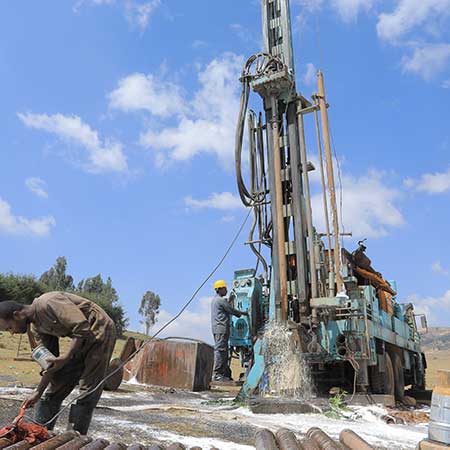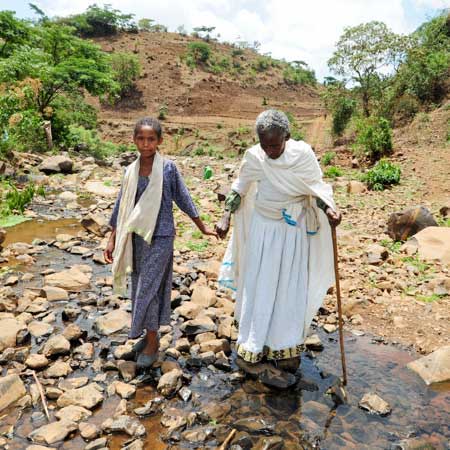
The dream of a new school
A class of their own
The children in Year 2 at Gago Osole School sit tightly packed on homemade benches. Among them are Ebisa and Ebise, who share not only the classroom, but also a dream: a new school in the village.

Ebisa is a bright young man. But the dust in the classroom gives him a hard time. Like many of his schoolmates, he suffers from a stubborn cough.
(Not) a good place for learning
Entering Year 2 of the school in Gago Osole makes you catch your breath, and for a short moment everything turns gloomy. It’s stuffy in the dark room, and a muted murmuring fills the air, now and then broken by the sound of a child coughing. Only after your eyes have grown accustomed to the darkness do you notice the countless pairs of eyes looking at you quizzically. How many are there? Fifty, maybe seventy? Overpowered by first impressions, it is hard to estimate the number of children in the room. “There’s only one class here, with more than a hundred children in it,” Director Ayele will explain later on. He’s right. There are actually over 150 children in Year 2. We are looking for Ebisa, the second-youngest child of farmer Alemu. We accompanied Alemu the day before and he is really enthusiastic about development in the region. His son has probably inherited something of this enthusiasm, and comes across as anything but shy – unlike so many of his classmates.
Dust, coughing and a lack of benches
Ebisa also has a bad cough and tells me in a scratchy voice what he would change about this school: “First of all, the benches and desks. Four of us sit here on one bench and it’s very dark in the classroom. The floor isn’t good either,” complains Ebisa, indirectly blaming the ground for his cough. Why? Because the floor in Gago Osole School consists mainly of compacted soil. The dust that gets kicked up causes severe respiratory illnesses in some of the children. But other dangers to their health also lurk in the floor. Sand fleas, which can bore into the children’s skin, also nest in the loose earth. They cause itchy, painful pustules, which often get inflamed.
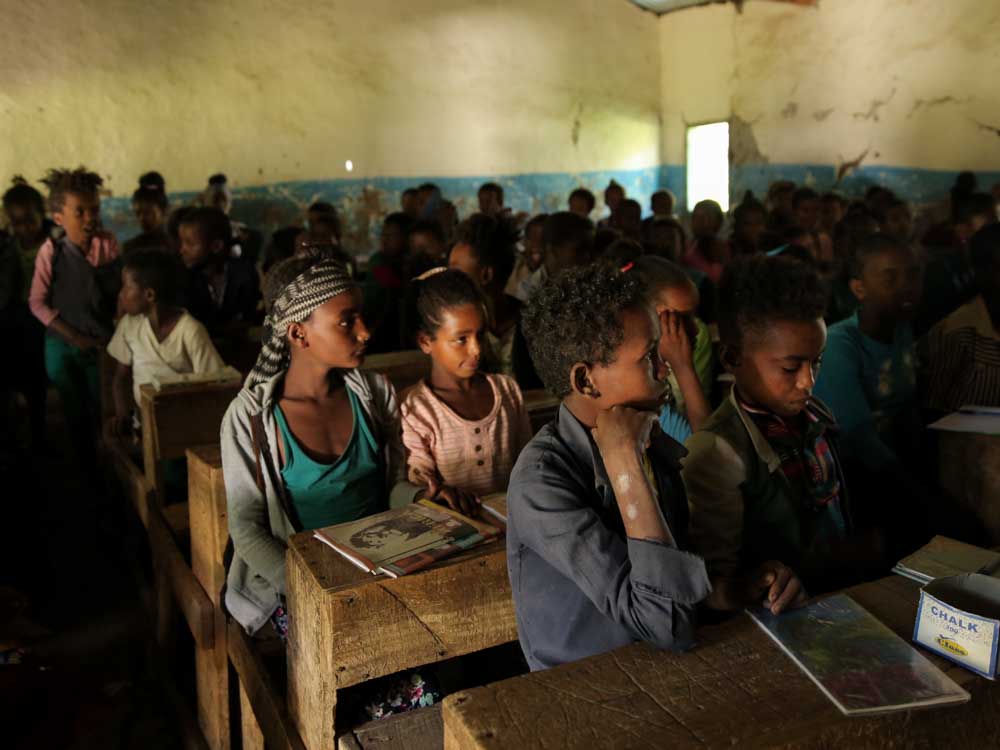
Too little space, dark and dusty. Learning is very difficult for the children at Gago Osole School.
Ebisa’s wish: a clean, bright school
At Menschen für Menschen, building a new school therefore starts not only with a good, stable foundation built of rocks, steel and concrete. “I visited my brothers and sisters at the new school in Hanfara Holoto,” says Ebisa enthusiastically. “Everything there is so nice and clean. I wish we had a school like that here.” It’s a wish that Ebisa shares not only with his classmates, but also of course with Director Ayele. “I went to school here myself. Back then, the building wasn’t yet in such a bad condition, but now it’s almost on the point of collapse,” complains Ayele. The school is built mostly of wood and clay, not very durable materials for the brutal Ethiopian weather. The structure is badly affected by the rainy season, but also by termite infestation.”
Improving the quality of learning
“Of course, the surrounding communities try to maintain the school as best they can, with money for this also being raised in the villages.” The benches and desks were made by members of the local communities themselves, but the effort put in by the population is a never-ending task. Fill a hole in one wall and another one appears somewhere else. A proper learning environment looks altogether different. But this is exactly what Director Ayele wants to create. “I’d like to improve the quality of learning here. But the buildings are old, the children don’t have enough space, and we have too few teachers for the large numbers of children,” says the 29 year-old, who also teaches at the school.

Director Ayele went to Gago Osole School himself. He knows first hand that there is an urgent need for action.
Better schools - more motivation
That the quality of teaching can dramatically improve through the construction of a new school was shown by an evaluation at the end of the first project phase in the Ginde Beret region. “It does seem to be the case that many teachers try to get posted to one of the newly built schools, and the new facilities are proving to be a source of motivation for teaching staff and pupils alike,” said assessor Anette Schmidt after her evaluation in October 2013. “That is clearly evident when you look at the dilapidated, dark, old schools. So it’s actually conceivable that even the teaching has improved – that surprised me.” Since the project was launched nine years ago, Menschen für Menschen has built 13 schools in the Ginde Beret region alone.
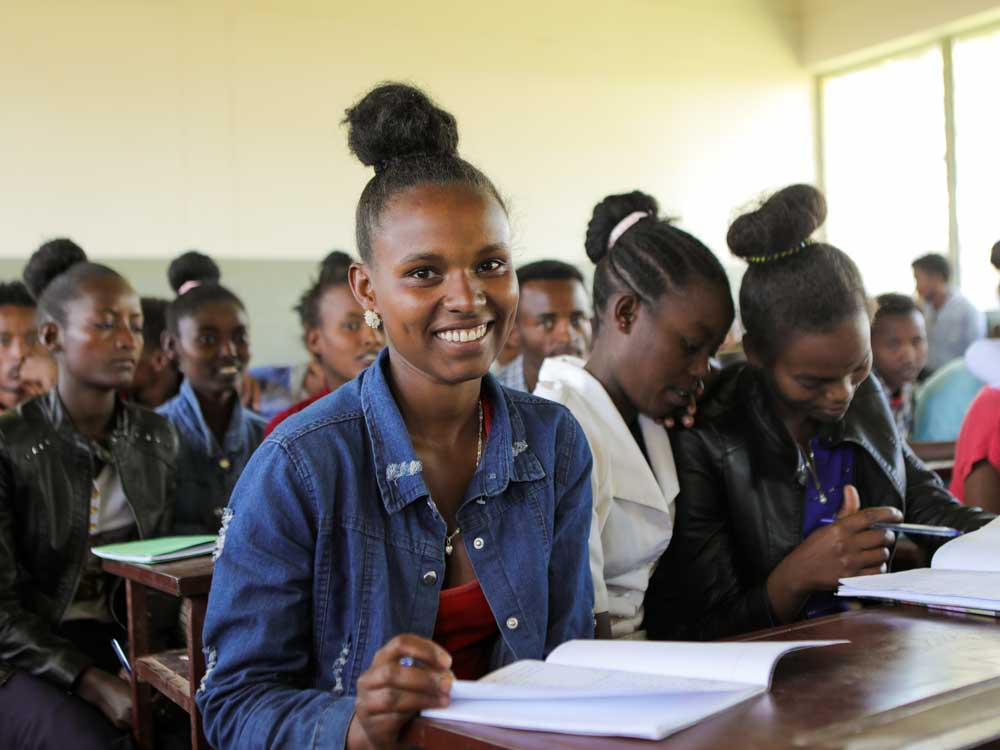
Ebisa’s sister Tigist goes to a newly built secondary school. “We have properly benches here, sufficient light and a nice desk.”
Access roads make the school
But before a school can be built, an access road has to be created. This is also the case in Gago Osole, a remote village at the foot of a high plateau. At present, only a narrow, steep stone track leads into the village, and can also only be driven on in dry weather by four-wheel-drive vehicles. “It’s simply impossible for trucks carrying the necessary machinery and construction materials to drive up here,” explains Berhanu Bedassa, project leader from Ginde Beret. This become quite clear as the vehicle of Menschen für Menschen clambers slowly up the mountain. When the plateau is finally reached after about half an hour and the driver deactivates four-wheel drive again, the stony road can be felt in every fiber of our bodies. Ahead lie a relatively level clay track and a bustling village center. An especially large number of young girls and boys are bustling around in Hanfara Holoto on this day, because registration for secondary school has commenced. Tamirat has also made his way here to find out whether his registration for Year 11 courses has been successful.
School makes the future
Tamirat is Ebisa’s elder brother. He also completed his basic education at the dilapidated school in Gago Osole. He has been attending the newly built school in Hanfara Holoto for two years now. “The school here can’t be compared with the one in our village. This one has proper windows and doors. There’s a cement floor which isn’t dusty like the one in the old school,” says Tamirat emphatically. His sister Tigist agrees with him. She changed to the new school just this year. “We have proper benches here, sufficient light and a nice desk. The school at home is almost falling apart. Sometimes bits of the wall even fall onto our schoolbooks,” reports the 18 year-old. Looking to the future, she’d like to train to be an accountant, while her brother wants to work as a doctor for his community. Ambitious goals, for which the siblings need a good foundation.
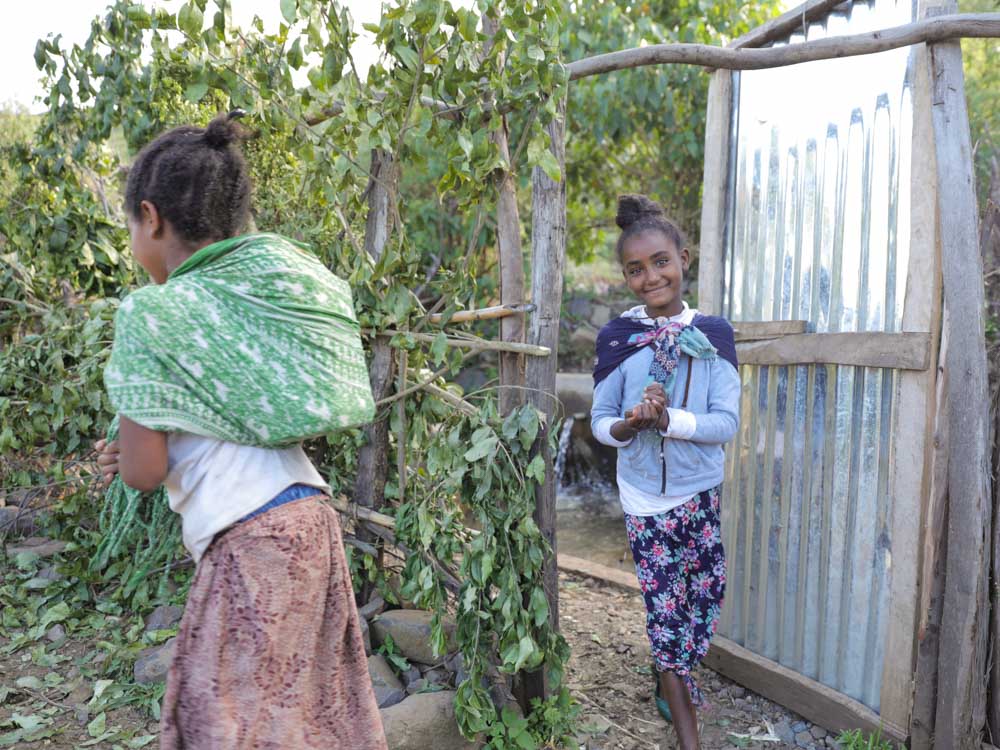
Ebise has learned how important clean water is. Since the standpipe was installed in her village, there has finally been clean water from the spring and Ebise has more time to study.
Key to development
The children in the dark classrooms of the school in Gago Osole also dream of their future. “I’d like to become a teacher,” says Ebisa’s classmate Ebise. “I like going to school because I also learn something about our nutrition and how important clean water is, for example.” A new standpipe was recently installed in Ebise’s village by Menschen für Menschen. “Fetching water is now much easier and the water is clean.” The construction of wells and standpipes is an important measure for enabling children to get an education. That is because building a school only makes sense if children can actually go to it.
Girls like Ebise in particular perform early-morning tasks like fetching water for the family. So if a village has a well, the girls save a lot of time, which they can spend on going to school and doing homework. And their health improves as well, of course. Ebise knows precisely what difference that makes for the children: “The water used to be very dirty and the animals also drank from it. Many of my classmates and I became sick from it and couldn’t go to school. Now, the water is clean and we are healthy.” And Ebise now has more time for school, homework and her favorite occupation. “When I have time, I prefer to read my schoolbooks or play the ‘handkerchief game’ with my brothers and sisters. That involves us sitting in a circle, and one of us goes round and hides a handkerchief behind one of the others. We then sing a little song called ‘Have you seen my handkerchief?’.”
We visited the children of Gago Osole School in October 2019 to record their stories and also make some videos.
We visited the children of Gago Osole School in October 2019 to record their stories and also make some videos.
Your donation will fulfill a big wish of children like Ebisa: a bright, stable school where they can learn successfully.



